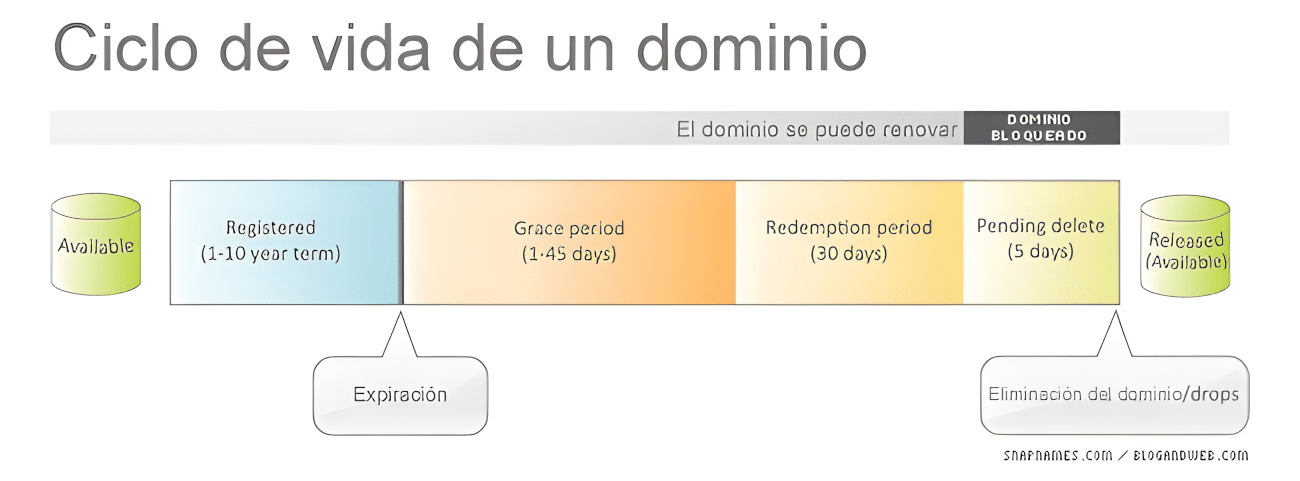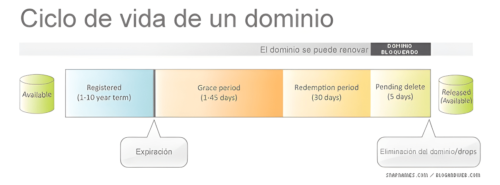Losing an expired domain for not being renewed is a relatively common problem, mainly in companies or people who delegated the registration to a third party or contracted the service indirectly with the hosting company.
Be that as it may, there are ways to recover a domain that has passed its expiration date, this depends essentially on the stage in which the domain is. The first thing to remember is the life cycle of a domain name:

How to recover an expired domain name
a) Grace period. The renewal is at normal price and the domain is usually still in the panel to renew directly. Several registrars even offer promotions as a way not to lose the customer.
b) Rendemption period. Renewal is possible directly with the registrar, but at a higher price. The domain may no longer appear in the panel and it is advisable to send an email to support to consult the renewal fee.
At this stage many registrars start an auction of the domain as a “drop”, if the domain receives bids, it will be awarded to the winner at the end of this period. Allowing a domain to drop in order to renew it at normal price could be a bad idea if the domain has a lot of visitors or is a good domain name.
c) Pending delete. At this point it can no longer be renewed directly, so recovering it requires a backorder with an external company. This is a topic worth expanding on.
Backorders
The backorder companies have agreements with several registrar companies and when the domain is deleted, their associates bombard with requests to obtain it the second it is released. The backorder companies have different prices and ways of operation, the main ones are:
- Dropcatch.com. It has two modes. Club, which starts at $10 USD and Regular, which costs $59 USD.
- Snapnames.com. The current price for a backorder is $59 USD. If only one person backorders the domain, it is awarded directly, if there is more than one backorder an auction is started between the interested parties. You only pay if you win the domain.
- Pool.com. The price per backorder is $60 USD. It works by auction and the payment method is the same as Snapnames.
- Godaddy. The price is $18.99 USD, payable in advance, even if you don’t get the domain; however, it can be used to backorder another domain. Only one person can backorder, so if Godaddy captures it directly it is yours.
Which Backorder service to choose?
It will depend on the quality of the domain, if the domain is very important to you it is advisable to do a backorder in Dropcatch and Snapnames, because in the end you will only pay where they got it and the probabilities of that are high, with a cost of about $60 USD.
If the domain does not have a great value for you, but you want to have more certainty than manual registration, Godaddy or Dynadot are a good enough option.
d) The domain was won by someone else. If the domain has already been registered by someone else, the only thing left to do is to negotiate with the new owner.
If we want to make the negotiation directly we can obtain the contact information from the whois of the domain. Negotiation requires knowing the real value of the domain, which in turn, needs experience to determine accuracy and make a real offer. It is best to first learn about domaining from specialized forums and previous comparable sales.
You can also leave the negotiation to a professional, a domainer or a specialized agency.
Conclusion
Rescuing a domain can be expensive and take time, obviously the ideal is to avoid that our important domains expire, how? renewing in advance and for several years. Renewing for three or five years directly is relatively expensive, but it can be more expensive to rescue or even lose an important domain.
Photo by aussiegall (cc)


